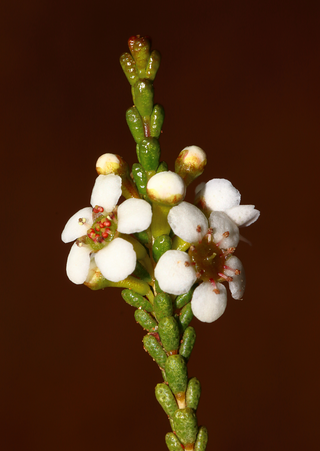
Agonis baxteri is a species of flowering plant in the family Myrtaceae and is endemic to the southwest of Western Australia. It is an erect, sometimes bushy shrub with elliptic to egg-shaped leaves with the narrower end towards the base, and usually white flowers with 23 to 32 stamens.
Micromyrtus arenicola is a species of flowering plant in the myrtle family, Myrtaceae and is endemic to a small area in the southwest of Western Australia. It is an erect shrub with small, linear to narrowly egg-shaped leaves and small white flowers.

Micromyrtus clavata is a species of flowering plant in the family Myrtaceae and is endemic to inland Western Australia. It is an erect, compact or sprawling shrub with erect, egg-shaped leaves with the narrower end towards the base and small white flowers arranged singly in upper leaf axils.
Micromyrtus collina is a species of flowering plant in the myrtle family, Myrtaceae and is endemic to a small area in the southwest of Western Australia. It is an erect shrub with small, linear to narrowly egg-shaped leaves and small white flowers that turn pink as they age.

Thryptomene australis, commonly known as hook-leaf thryptomene, is a species of flowering plant in the family Myrtaceae and is endemic to the south-west of Western Australia. It is an erect, bushy and spreading shrub with upward-pointing leaves with the tip curving outwards, and flowers with white petals arranged spike-like near the ends of the branchlets.
Thryptomene costata is a species of flowering plant in the family Myrtaceae and is endemic to Western Australia. It is an erect shrub with upward pointing, egg-shaped leaves with the narrower end towards the base, and white or pink flowers with five petals and ten stamens.
Thryptomene calcicola is a species of flowering plant in the family Myrtaceae and is endemic to a small area in the north-west of Western Australia. It is an erect, sometimes spreading shrub with upwards-pointing linear leaves, and pinkish-mauve flowers with five petals and ten stamens.
Thryptomene eremaea is a species of flowering plant in the family Myrtaceae and is endemic to Western Australia. It is an erect shrub with upward-pointing, oval leaves and white or pale pink flowers with five petals and ten irregularly arranged stamens.
Thryptomene globifera is a species of flowering plant in the family Myrtaceae and is endemic to western areas of Western Australia. It is a shrub with crowded, upward-pointing, broadly egg-shaped leaves with the narrower end towards the base, and pale pink or mauve flowers with ten stamens.
Thryptomene hubbardii is a species of flowering plant in the family Myrtaceae and is endemic to a small area in the west of Western Australia. It is a spreading shrub with crowded broadly egg-shaped leaves with the narrower end towards the base, and flowers with five pale pink petals and nine or ten stamens.
Thryptomene johnsonii is a species of flowering plant in the family Myrtaceae and is endemic to a restricted area of Western Australia. It is a bushy shrub with rigid branches, egg-shaped leaves with the narrower end towards the base and pink flowers with five petals and usually eight stamens.

Thryptomene mucronulata is a species of flowering plant in the family Myrtaceae and is endemic to Western Australia. It is an erect shrub with upward-pointing, overlapping, egg-shaped leaves with the narrower end towards the base and pink flowers with five petals and ten stamens.
Thryptomene nitida is a species of flowering plant in the family Myrtaceae and is endemic to a small area in the south-west of Western Australia. It is a spreading shrub with upward-pointing, egg-shaped leaves with the narrower end towards the base, and flowers with five pale purple or pinkish petals and ten stamens.
Thryptomene orbiculata is a species of flowering plant in the family Myrtaceae and is endemic to the west of Western Australia. It is a shrub with broadly egg-shaped to more or less round leaves, and flowers with five pinkish petals and usually ten stamens.
Thryptomene podantha is a species of flowering plant in the family Myrtaceae and is endemic to the west of Western Australia. It is a shrub with egg-shaped leaves with the narrower end towards the base, and flowers with pink sepals and petals and ten stamens.
Thryptomene repens is a species of flowering plant in the family Myrtaceae and is endemic to a restricted area in the west of Western Australia. It is a prostrate shrub with egg-shaped leaves with the narrower end towards the base, and flowers with pink sepals and petals and ten stamens.

Babingtonia camphorosmae, commonly known as camphor myrtle, is a species of flowering plant in the family Myrtaceae and is endemic to the southwest of Western Australia. It is a prostrate to low-growing shrub with linear to thread-like leaves and white or pink flowers in groups of up to five, each flower with ten to thirteen stamens.
Babingtonia delicata is a species of flowering plant in the family Myrtaceae and is endemic to a small area in the southwest of Western Australia. It is a slender shrub with erect stems, linear leaves and bright pink flowers in groups of up to three, each flower with 4 to 8 stamens.
Babingtonia erecta is a species of flowering plant in the family Myrtaceae and is endemic to the southwest of Western Australia. It is an erect shrub with densely clustered, linear leaves and white or pale pink flowers in groups two to seven in leaf axils, each flower with 8 to 14 stamens.
Babingtonia fascifolia is a species of flowering plant in the family Myrtaceae and is endemic to the southwest of Western Australia. It is a shrub with erect, slender stems, linear leaves and white or pale pink flowers in groups two to seven in leaf axils, each flower with 19 to 23 stamens.






